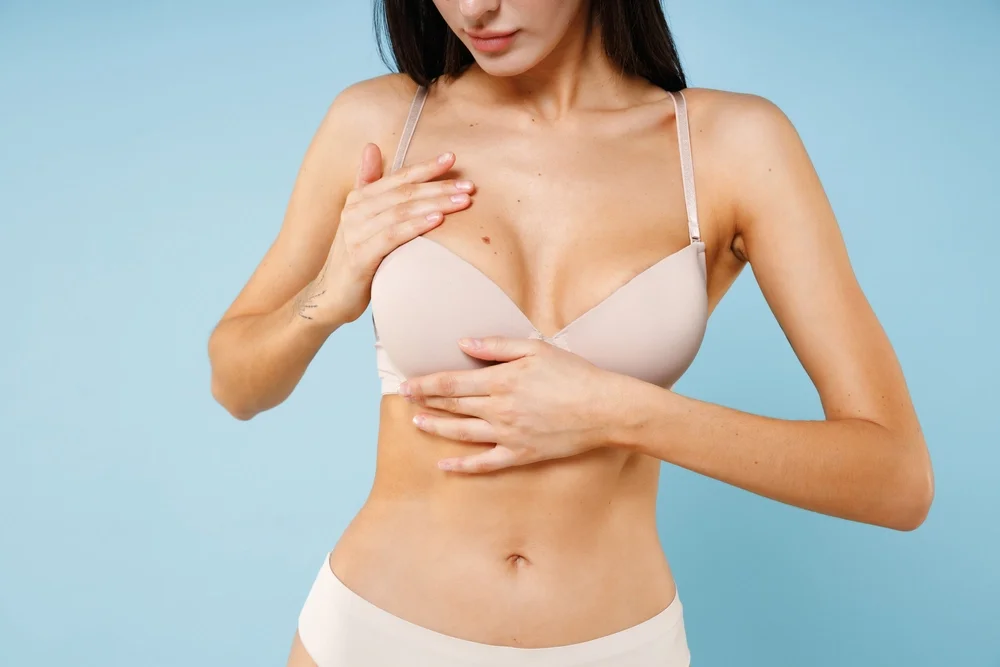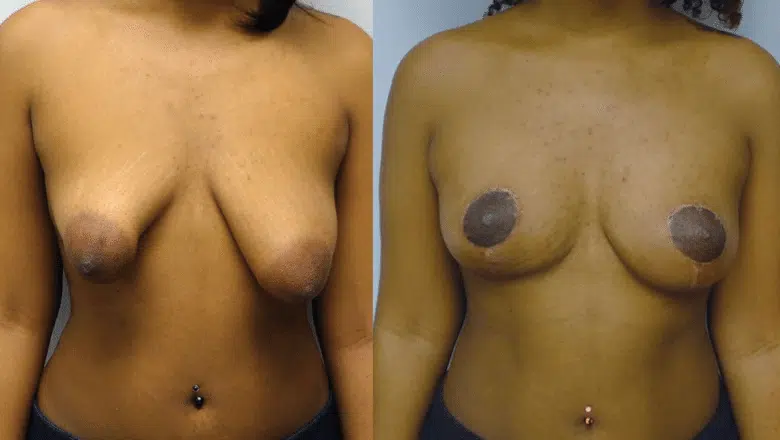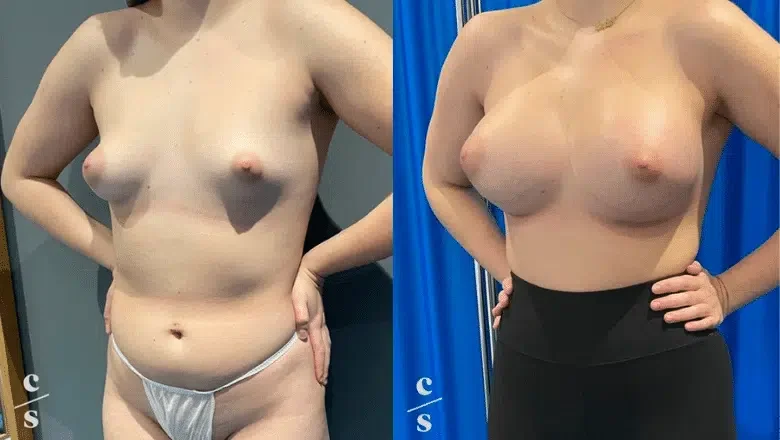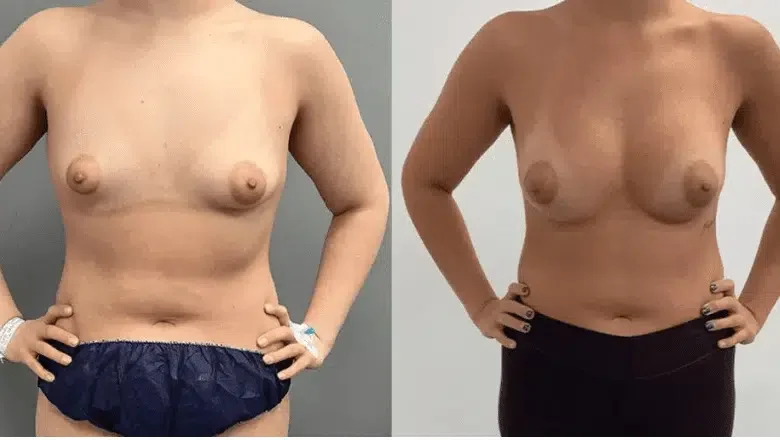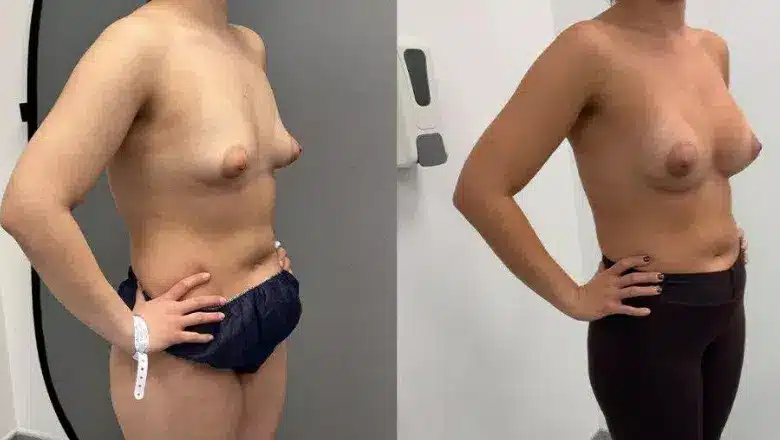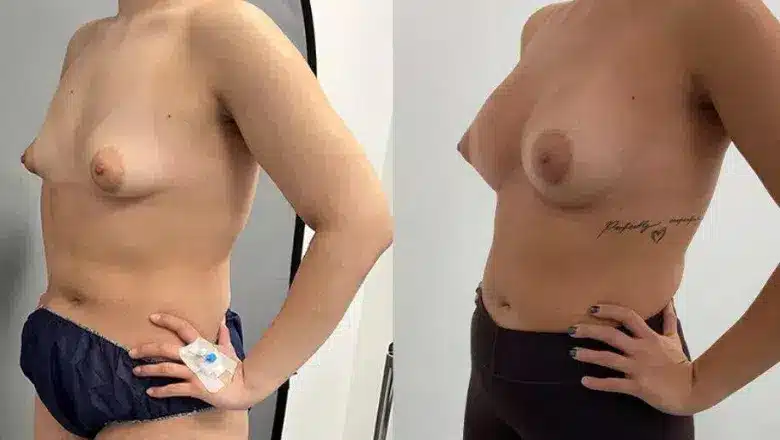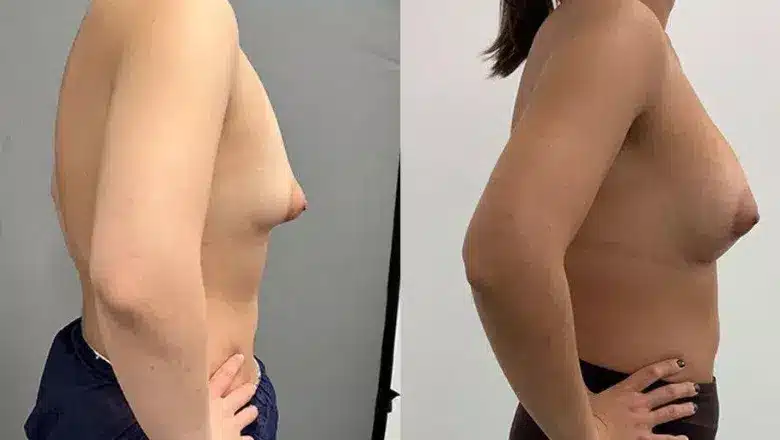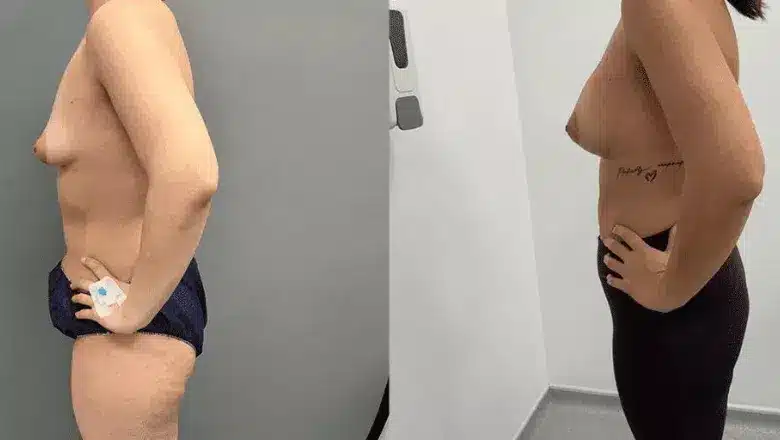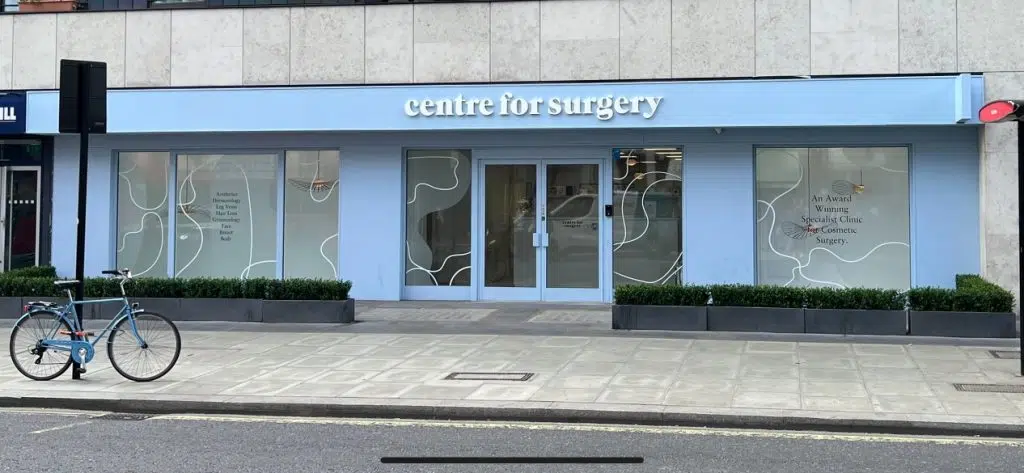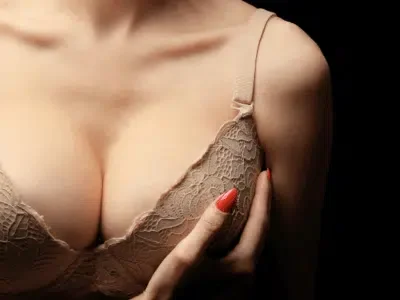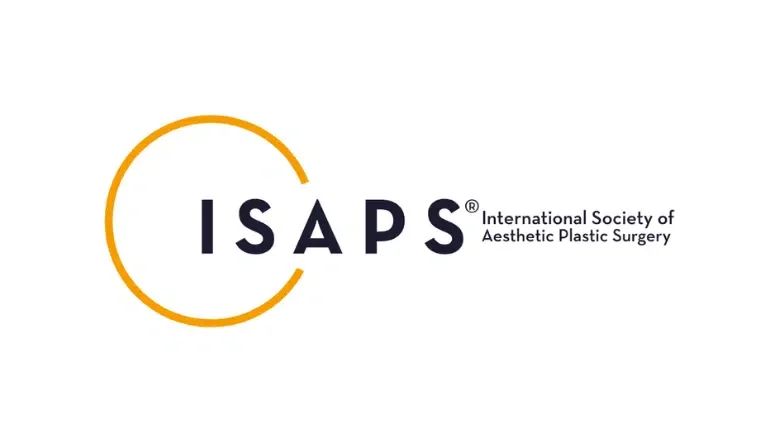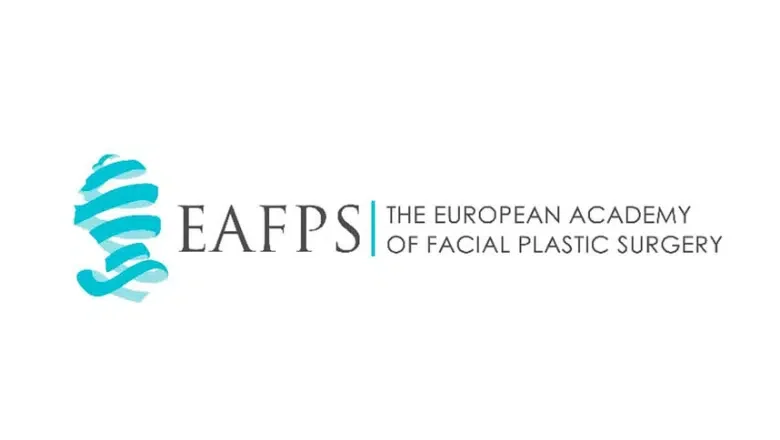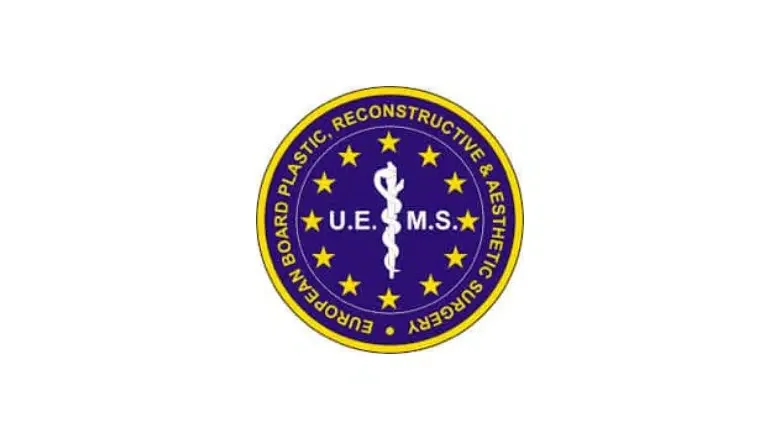Tuberous & Tubular Breast Correction in London
Tuberous breast correction is a surgical procedure to correct the appearance of tubular or tuberous breasts. Tubular breasts are unusual in that they appear in keeping with a conical shape, like a tube, rather than round in shape. They have a small, constricted base with a breast mound, which has the shape of a narrow cone and overly large nipples and areolas. Tubular breasts can affect one or both breasts. It is quite common for tubular breasts to differ from one another, and it is also common for the areola area to have an enlarged and domed appearance.
The condition is thought to be due to disordered growth of the immature breast, leading to abnormally shaped, small and sagging breasts or breast hypoplasia. Tuberous breasts are also referred to as tubular breasts. Tubular breasts are surprisingly common and typically occur in younger women. Although there are no medical risks of tubular breasts, they can result in a significant cosmetic deformity, leading to a significant loss of confidence. Tubular breasts can vary in the grades of deformit,y with mild, moderate and severe tubular breasts. Whilst the true explanation for why women develop tubular breasts is still unknown, some say it is a congenital condition, and tubular breasts tend to become obvious during puberty.
Is there a solution to the correction of tubular breasts?
Tubular breasts can only be corrected with a reconstructive surgical procedure. There are no non-surgical treatments proven to be effective for tubular breasts. At Centre for Surgery, our surgeons use the latest surgical techniques, including breast augmentation using both silicone breast implants and/or fat transfer for effective and permanent correction. For women who are not keen on breast implants, a mastopexy or breast lift is another option for tuberous breast correction. Although tuberous breast correction is a challenging procedure to perform, our surgeons have years of experience and treat many cases of tubular breasts annually. Having tubular breast correction at Centre for Surgery can restore your confidence.
What Do Tuberous Breasts Look Like?
Tuberous breasts, also known as constricted or tubular breasts, are a type of breast shape anomaly that can affect both men and women. This condition occurs when the breast tissue fails to develop fully during puberty, resulting in a narrow, elongated shape with a higher than normal breast crease. The breasts may also appear underdeveloped or “puffy” due to an excess of glandular tissue.
RELATED: What Are Tuberous Breasts?
Tuberous breasts can take on a variety of appearances, but some common characteristics include a narrow base, a high crease beneath the breast, and a conical or elongated shape. The areola may also be enlarged and/or herniated due to the excess glandular tissue. In more severe cases, the breasts may be very small or asymmetrical.
As shown below, tubular breasts result in a deficiency in the breast’s vertical and/or horizontal dimensions, frequent underdevelopment of the breast, and often a herniation of breast tissue into the areola accompanied by an expansion of the areola.

There are various grades of tuberous breasts, ranging from mild to severe, based on the extent of the deformity. In mild cases, the breast may simply have a narrow base with a slightly elongated shape, while in severe cases, the breast may be severely constricted with a narrow base and a protruding areola.
Tuberous breasts can cause physical discomfort, such as pain or discomfort during exercise or difficulty finding clothing that fits properly. They can also have a significant impact on a person’s self-esteem and body image, leading to feelings of self-consciousness or embarrassment.
RELATED: How Common are Tubular Breasts?
Fortunately, there are options for correcting tuberous breasts. Tuberous breast correction surgery involves releasing the constricted breast tissue and reshaping the breast to achieve a more natural, symmetrical appearance. This may involve a combination of breast augmentation, breast lift, and tissue reshaping techniques, tailored to the individual’s specific needs. The surgery can help alleviate any physical discomfort and improve a person’s confidence and self-esteem.
What Is Tuberous Breast Surgery?
Tuberous breast surgery, also known as tuberous breast correction, is a breast reconstruction procedure that is used to address tuberous breasts, a condition where the breasts are constricted, narrow, and tubular in shape due to incomplete breast development during puberty. This condition can have a profound impact on a person’s self-esteem, body image, and physical well-being, as well as cause discomfort.
RELATED: Tubular Breasts – Causes and Treatments
Tuberous breast surgery involves releasing the constrictions and reshaping the breasts to create a more natural, symmetrical appearance. The procedure may involve a combination of breast augmentation, breast lift, and tissue reshaping techniques, tailored to the individual’s specific needs. The surgery can help improve the size, shape, and position of the breasts, resulting in a more balanced and proportionate appearance.
What causes Tubular Breasts?
Tuberous breast deformity is a condition where the breasts do not develop properly during puberty, which can affect one or both breasts. The exact cause of this condition is not fully understood. However, some doctors believe it may be congenital, resulting from an unknown event during fetal development that becomes evident during puberty. Regardless of the underlying cause, tuberous breasts do not develop enough tissue to become round, large, and perky, resulting in narrow, tube-shaped, and small breasts. In some cases, the tissue surrounding the nipple also fails to develop correctly, leading to puffy, droopy nipples.
RELATED: Tubular Breasts – Causes and Treatments
Types of Tuberous Breasts – Three Grades – What are the different degrees of tubular breasts?
Tuberous breasts, also known as tubular breasts, are a breast shape anomaly that can affect the size, shape, and position of the breasts. There are three grades of tubular breasts, each with different characteristics and severity.
Grade 1
Grade 1 tubular breasts are the mildest form of the condition. They are characterised by a minimal constriction at the base of the breast, which can cause the breast to be slightly narrow and elongated in shape. The areola may be enlarged or puffy, but the nipple typically points outward and is not severely affected.
Grade 2
Grade 2 tubular breasts are a moderate form of the condition. They are characterised by a more pronounced constriction at the base of the breast, which causes the breast to have a more tubular shape. The areola and nipple may be puffy, and the nipple may be slightly inverted or displaced from its normal position.
Grade 3
Grade 3 tubular breasts are the most severe form of the condition. They are characterised by a significant constriction at the base of the breast, causing the breast to have a very narrow, tube-like appearance. The areola and nipple may be severely displaced or inverted, and there may be a significant amount of breast tissue in the upper part of the breast.
Tuberous breasts can affect one or both breasts and can be a source of physical discomfort and psychological distress for individuals who have them. Tuberous breast correction surgery can help to reshape and reposition the breast tissue to create a more natural, symmetrical appearance. The surgical technique used will depend on the individual’s unique anatomy and desired outcome.
Tuberous Breast Correction Before & After Photos
Benefits of Tuberous Breast Surgery
Tuberous breast surgery can provide numerous benefits for individuals with tuberous breasts. Here are some of the main benefits of tuberous breast surgery:
Improved breast appearance
Tuberous breast surgery can help reshape and enlarge the breasts, creating a more natural, symmetrical appearance. The procedure can correct the narrow base, elongated shape, and enlarged areolas associated with tuberous breasts, resulting in a more balanced and proportionate appearance.
Increased self-confidence
Tuberous breast surgery can have a significant impact on a person’s self-esteem and body image. Individuals who have been self-conscious or embarrassed about their tuberous breasts may feel more confident and comfortable after the surgery, leading to an improved quality of life.
Alleviated physical discomfort
Tuberous breasts can cause physical discomfort or pain due to their shape or size. Tuberous breast surgery can alleviate these symptoms by correcting the shape and size of the breasts, resulting in a more comfortable and natural feel.
More clothing options
Individuals with tuberous breasts may have difficulty finding clothing that fits properly due to their unusual breast shape. Tuberous breast surgery can provide a more normal breast shape, allowing for more clothing options and a wider range of styles to choose from.
Enhanced overall health
Tuberous breast surgery can also provide health benefits for some individuals. For example, women with tuberous breasts may have difficulty breastfeeding due to their breast shape. Tuberous breast surgery can correct this problem and improve the overall health of both mother and child.
RELATED: How to Fix Tuberous Breasts
Preparation for Tubular Breast Correction
Our surgeons strongly believe that the success of any cosmetic surgery procedure, including tubular breast correction surgery, is optimised with the following of all of the surgeon’s pre-procedure instructions.
We always strive to go above and beyond to make sure all our patients are optimally prepared for breast lift surgery – physically, mentally and emotionally.
Surgical Options for Tubular Breasts
The only way to treat tubular breasts is through corrective surgery, which can be performed using traditional surgical reconstruction methods, with or without implants, or through fat grafting. It’s important to note that regular cosmetic surgery may not be enough to fully correct tubular breasts. Therefore, it’s crucial to choose a surgeon who has experience in treating tubular breasts specifically.
Conventional Tuberous Breast Correction Techniques
The standard approach to correcting tuberous breasts typically involves surgical tissue reshaping, akin to a breast lift, and may also include the use of breast implants. A periareolar incision, which encircles the nipple, is commonly employed.
Tuberous breast reconstruction typically encompasses the following steps:
- Glandular scoring, a technique that involves releasing the constricted tissue surrounding the breast’s base to create a more rounded appearance
- Distributing some of the breast tissue into the lower portion where it is deficient
- Refashioning the inframammary fold to establish a distinct lower breast curve
- Elevating the nipple to a more proportionate position through a breast lift
- Reducing the size of enlarged areolas
- Minimising the distance between the breasts
- In cases where an individual’s natural breast tissue is insufficient for satisfactory results, breast implants may be necessary. This could involve two separate surgeries, although a single procedure may suffice for grade I tuberous breasts. For grade II and III cases, a staged process over 9 to 12 months is often required.
Breast tissue expanders are typically used only in severe, grade III cases, while direct implantation is the standard for grades I and II.
- During the initial surgery, temporary inflatable implants called tissue expanders are placed.
- These expanders gradually stretch the chest muscles and skin, making room for the permanent implants.
- The expanders remain in place for several weeks or months and are routinely inflated by the surgeon.
- Once the breasts have reached the desired size, a final corrective surgery is performed, and the expanders are replaced with permanent implants.
In the majority of cases, breast implants alone are insufficient, and surgical tissue reshaping (lifting) is necessary to achieve optimal results. This procedure addresses sagging and imparts a more youthful and perky appearance to the breasts.
What are the benefits of conventional tuberous breast correction?
- Elimination of the tubular appearance by creating a rounded breast base
- Enhanced breast symmetry
- Larger and fuller breasts with improved aesthetic appeal
- Refined breast contour and a more pronounced cleavage
- Long-lasting outcomes
- Reduced distance between the breasts
What are the drawbacks of conventional tuberous breast correction?
Given the varying degrees and types of tuberous breasts, traditional tuberous breast correction surgery may have specific limitations:
- Exposed implant edges, if there is insufficient tissue in the lower part of the breast, leading to an unnatural appearance
- Implant placement might result in a wide cleavage
- “Double bubble” effect can occur if the implant descends below the lower part of the breast due to inadequate lower breast support.
- Extended recovery time may be necessary after implant insertion
- Potential loss of sensation in the nipples
- Risks of hematoma, seroma, or postoperative infections
- Scarring on the breasts, although these can be effectively concealed
Fat Grafting for Tuberous Breasts
Fat grafting has emerged as a popular and less invasive solution to remodel tubular breasts without using implants.
During a fat grafting procedure, excess fat is removed from one area of the body through liposuction and then injected strategically into the breasts to remodel and inflate them. Unlike traditional implants or breast reduction, fat grafting does not involve cutting or manipulating the glandular tissue in the breast. Instead, the surgeon targets specific areas of the breast and enhances them as needed, resulting in a more natural-looking breast mound.
Fat grafting also has several advantages over traditional breast surgeries. The targeted injection of fat can improve the shape and volume of the breasts without causing significant damage to the glandular tissue. Moreover, fat grafting does not require scoring of the breast tissue, resulting in a lower risk of surgical complications such as hematoma, seroma, and infection. Additionally, fat grafting can help soften the breasts, reducing their firmness and pointy appearance.
While fat grafting has numerous advantages, it also has some disadvantages to consider. For example, some women may not be able to increase their breast size with fat grafting significantly. In such cases, multiple sessions may be needed to achieve the desired long-term outcome. Moreover, pre-expansion techniques may be necessary to enhance the breasts and improve their long-term consequences.
Another potential drawback of fat grafting is that if too much fat is injected at once, fat necrosis (cell death) can occur, resulting in the formation of hard lumps in the breast tissue. However, experienced plastic surgeons are skilled at avoiding these complications and ensuring that the procedure is performed safely and effectively.
Hybrid Breast Augmentation – Breast Implants combined with Fat Grafting
For women seeking breast augmentation, a hybrid breast augmentation, or composite breast augmentation, combining both breast implants and fat grafting, can offer several advantages over traditional techniques. This approach is beneficial for treating tuberous breasts. In this condition, the breast tissue does not develop correctly, resulting in a narrow base, a pointed or tubular shape, and an overall asymmetrical appearance.
Combining breast implants and fat grafting allows the surgeon to achieve more volume, more strategic contouring, and a more pronounced cleavage. Moreover, the results of hybrid breast augmentation are more long-lasting than those of fat grafting alone. By using both techniques, the surgeon can enhance the breasts’ overall appearance and create a more natural-looking outcome.
However, traditional breast implant techniques have several limitations when it comes to treating tuberous breasts. For example, breast implants alone are not ideal for the lower and outer aspects of the breast, which are often covered by thin skin and lack underlying breast tissue. This can make the implants more visible, creating an unnatural appearance.
When breast implants are placed under the chest muscle, it can limit the expansion of the medial breast, resulting in a wide cleavage. Additionally, the placement of implants under the muscle can cause a permanent crease on the lower aspect of the breast if the implant does not fully expand the natural breast tissue.
Another issue with traditional techniques is the use of glandular scoring, which involves cutting and scoring the glandular tissue to release the constriction and allow for breast implant insertion. This process can be painful, require considerable recovery time, and increase the risk of nerve damage, bleeding, and breast haematoma.
To mitigate these risks and explore a less invasive solution, fat grafting is now being utilised to treat tuberous breasts. By using fat grafting, the surgeon can selectively thicken areas of the breast tissue and create a more natural-looking curve. This technique can also be used in combination with breast implants to enhance the breasts’ overall shape and achieve a more natural-looking outcome.
Recovery after Tuberous Breast Correction Surgery – What to Expect
Corrective cosmetic breast surgery, including tuberous breast reconstruction, is generally considered safe. However, as with any breast augmentation surgery, postoperative restrictions on movement and activities are expected.
Here’s what to anticipate during recovery from tuberous breast reconstruction:
- Swelling and puffiness may persist for up to four weeks after surgery.
- Some pain and discomfort are normal but can be managed effectively with oral pain medication.
- Plan for at least one week of rest at home, with no work and minimal physical exertion.
- You can usually resume exercise within 3-4 weeks following surgery, gradually increasing intensity as tolerated.
- High-intensity cardiovascular activities should be avoided for 12 weeks to promote optimal healing.
- Your surgeon may advise wearing a supportive (surgical) bra for a month after surgery to help with healing and shaping.
- To minimise pressure on the breasts, sleep on your back for a month after surgery.
While you will likely notice a significant improvement in the appearance of your breasts immediately after tuberous breast reconstruction, the final results may take 1-2 months to settle fully. The swelling should have subsided by this point, and any bruising should have dissipated. Over the following months, your breast scars will mature and gradually fade, blending in with the surrounding skin. Remember that individual healing times and experiences may vary, so it is essential to follow your surgeon’s specific postoperative care instructions and attend all scheduled follow-up appointments.
Tuberous Breast Surgery Costs London - How Much Does Tubular Breast Surgery Cost in London UK? Prices & Fees
The cost of tuberous breast surgery in London, UK can vary depending on a number of factors, such as the extent of the surgery and the surgeon’s experience and expertise. At Centre for Surgery in London, the cost of tuberous breast surgery typically ranges from £6,500 to £9,500.
The exact cost of the procedure will depend on the individual’s needs and goals, and will be determined during a consultation with the surgeon. The consultation will also allow the surgeon to discuss the potential risks and benefits of the procedure and to develop a customised treatment plan based on the individual’s unique anatomy and desired outcome.
The cost of tuberous breast surgery includes the surgeon’s fees, anaesthesia fees, and facility fees. We also offer financing options to make the procedure more affordable for patients who may not be able to pay the full cost upfront.
Selecting a qualified, experienced plastic surgeon with a strong reputation for performing successful tuberous breast surgery procedures is crucial. Centre for Surgery is staffed by experienced, certified plastic surgeons who specialise in tuberous breast surgery and other breast enhancement procedures.
Does the NHS cover Tubular Breast Surgery?
Tuberous breast surgery may be covered by the National Health Service (NHS) in some instances. The NHS provides medical care and treatments free of charge for eligible individuals in the United Kingdom, based on clinical need rather than the ability to pay.
However, the availability of tuberous breast surgery on the NHS may depend on several factors, including the severity of the condition, the impact on the individual’s physical and mental health, and the availability of funding and resources. In general, tuberous breast surgery is more likely to be covered by the NHS if it is deemed medically necessary, such as in cases where the individual is experiencing physical discomfort or pain.
Enhancing Aesthetic Outcomes: Complementary Procedures with Tubular Breast Correction
Breast Augmentation
For individuals undergoing tubular breast correction, breast augmentation with implants can provide additional volume and improve breast shape. This procedure allows for a wide range of implant sizes, shapes, and materials, offering a customizable solution to achieve the desired breast fullness and symmetry. The selection of implants is crucial in addressing the specific characteristics of tubular breasts, ensuring a natural-looking outcome that harmonises with the body’s proportions.
Fat Grafting
Fat grafting, also known as autologous fat transfer, can be an excellent adjunct to tubular breast correction. By transferring fat from other body areas (such as the abdomen or thighs) to the breasts, surgeons can fine-tune the breast shape, address asymmetries, and enhance softness. This technique is particularly beneficial for creating smoother transitions and contours, especially in the cleavage area, offering a more natural and seamless appearance.
Liposuction:
Liposuction can be strategically employed in areas adjacent to the breasts, such as the underarm, back, or even the abdominal region, to enhance the overall body contour and highlight the newly corrected breast shape. By removing excess fat deposits, liposuction complements the breast correction by defining a more aesthetically pleasing and balanced silhouette, ensuring that the improvements are not isolated to the chest but are reflected across the body.
Abdominoplasty
In cases where individuals seek a comprehensive transformation, combining tubular breast correction with abdominoplasty (or tummy tuck) can be highly effective. This procedure tightens abdominal muscles and removes excess skin, resulting in a flatter and more toned abdomen. The combination of abdominal contouring with breast correction can dramatically enhance body proportions, particularly beneficial for those looking to address changes following pregnancy or significant weight loss.
Why Choose Centre for Surgery for Tuberous Breast Correction?
Centre for Surgery is a leading cosmetic surgery clinic with significant experience in all types of aesthetic breast surgery, including breast augmentation, breast lift, breast reduction, and fat transfer to breasts. The clinic owns and manages its surgical facilities, providing patients with a comfortable and safe environment for their procedures.
Properly performed tubular breast correction surgery takes time and should not be rushed. At Centre for Surgery, the highly skilled and experienced plastic surgeons take their time to ensure that each patient receives the best possible outcome from their procedure. The surgeons are renowned experts in breast surgery, with a combined total of many years of experience. They are also full members of various professional organisations, including the British Association of Plastic, Reconstructive, and Aesthetic Surgeons (BAPRAS).
Centre for Surgery’s approach to aftercare is outstanding, according to its regulator, the Care Quality Commission (CQC). The clinic’s postoperative support team phones all patients the day after their procedure and then every other day thereafter for the first two weeks. This proactive approach to aftercare ensures that any complications are detected and treated promptly, reducing the impact of complications on patients’ recovery.
Centre for Surgery offers a comprehensive treatment package for patients seeking tuberous breast correction surgery. The package includes the following:
- As many preoperative consultations with your surgeon as you like to make sure the tuberous breast correction procedure is right for you.
- Treatment at a specialist day surgery facility recently rated ‘Good’ by the CQC.
- Enhanced same-day discharge with the added benefits of recovering in your own home.
- 24/7 clinical support from your surgeon for the first 48 hours and our expert postoperative support team.
- Your very own dedicated patient coordinator to guide you through the entire process.
- In-depth preoperative medical assessment to ensure that you are fully fit for your procedure.
- Exceptionally high standards of postoperative care are described as ‘outstanding’ by the CQC, including regular telephone and face-to-face checks.
- RealSelf Top Doctors status.
RealSelf Top Doctors

FAQs
-
What are tubular breasts?Tubular or tuberous breasts are the term given to breasts that have failed to develop normally. Normal breast tissue has a more even distribution of tissue across the base of the breast. Tubular or tuberous breasts have a long an narrowed appearance with a nipple that appears domed. The fundamental problem lies in an underdeveloped lower pole leading to a constricted lower ring around the breast.
-
Are tubular breasts common?Tuberous breasts, also known as constricted or tubular breasts, are a relatively rare breast shape anomaly, affecting a small percentage of women. While the exact prevalence is unknown, some estimates suggest that tuberous breasts may occur in less than 5% of women. However, it's important to note that breast asymmetry, which can also be caused by tuberous breasts, is actually quite common, with most women having some degree of asymmetry between their breasts.
-
At what age do tubular breasts become noticeable?Tubular breasts can become noticeable during puberty when breast development occurs. The exact age at which tubular breasts become noticeable can vary, but it typically occurs around the onset of puberty, which is usually between the ages of 8 and 13 years old. In some cases, tubular breasts may not become noticeable until later in life, such as during pregnancy or weight fluctuations.
-
Does PCOS cause tubular breasts?While there is no direct correlation between Polycystic Ovary Syndrome (PCOS) and tubular breasts, PCOS can cause hormonal imbalances that may impact breast development. PCOS is a hormonal disorder that can cause irregular periods, weight gain, and acne, among other symptoms. It is caused by an excess of androgens (male hormones) in the body, which can interfere with the normal function of the ovaries.
While the exact cause of tubular breasts is not fully understood, the condition is believed to be related to genetics and hormonal imbalances. It is possible that hormonal imbalances caused by PCOS may contribute to the development of tubular breasts. However, not all women with PCOS will develop tubular breasts, and tubular breasts can occur in women who do not have PCOS. -
Are tuberous breasts genetic?Yes, tuberous breasts can be genetic. While the exact cause of tuberous breasts is not fully understood, research suggests that genetics may play a role. Studies have shown that tuberous breasts can run in families, suggesting that there may be a genetic component to the condition.
Tuberous breasts can also be caused by hormonal imbalances during puberty, which can be influenced by genetics. Hormonal imbalances can interfere with normal breast development, resulting in tubular breast shape and other characteristic features of the condition. -
Can tuberous breasts be fixed?Yes, tuberous breasts can be fixed or corrected through a surgical procedure known as tuberous breast correction. Tuberous breasts are caused by incomplete breast development during puberty, resulting in a narrow, elongated breast shape with a higher than normal breast crease. This condition can cause physical discomfort and have a significant impact on a person's self-esteem and body image.
Tuberous breast correction involves releasing the constrictions and reshaping the breasts to create a more natural, symmetrical appearance. The procedure may involve a combination of breast augmentation, breast lift, and tissue reshaping techniques, depending on the individual's needs. The surgery can improve the size, shape, and position of the breasts, resulting in a more balanced and proportionate appearance.
The results of tuberous breast correction surgery can be long-lasting and can provide significant improvements in breast shape and size, leading to a boost in self-esteem and confidence. -
Can tuberous breasts be fixed naturally?While there are no natural remedies that can completely cure tuberous breasts, there are some non-surgical methods that may help improve their appearance to some extent. These methods include:
Breast massage: Gently massaging the breasts can help improve blood flow and promote breast tissue growth, which may help improve breast shape and size.
Breast enlargement creams: Some natural breast enlargement creams contain herbal ingredients that may stimulate breast tissue growth and improve breast size and shape.
Weight gain: In some cases, weight gain can help improve the appearance of tuberous breasts, as the breasts may become fuller and rounder with increased fat deposits. -
Can tubular breasts be corrected without implants?Yes, tubular breasts can be corrected without the use of breast implants. Tuberous breast correction surgery can involve a combination of procedures to reshape and reposition the existing breast tissue to create a more natural, symmetrical appearance.
One common technique used to correct tubular breasts without implants is a breast lift. This procedure involves removing excess skin and repositioning the breast tissue to create a more natural breast shape and position. The surgeon may also reshape the breast tissue to create a more rounded appearance, and reduce the size of the areola if necessary.
Another technique used to correct tubular breasts without implants is fat transfer. This procedure involves harvesting fat from another area of the body and injecting it into the breasts to add volume and improve the breast shape. Fat transfer can be a good option for individuals who have enough excess fat in another area of the body to be used for the procedure. -
Can Fat Grafting help Tuberous Breasts?Tuberous breasts are a relatively common breast deformity that can occur in women during their development. This condition can cause the breasts to have a narrow base, a pointed or tubular appearance, and an overall asymmetrical shape. Many women who have tuberous breasts often feel self-conscious and unhappy with their appearance. Fortunately, plastic surgery offers various solutions to correct this condition, including fat grafting.
Fat grafting, also known as fat transfer, is a procedure where excess fat is removed from one area of the body and transplanted to another area to enhance volume and shape. In the case of tuberous breasts, fat grafting involves taking fat from other parts of the body and strategically injecting it into the breasts to increase their volume and create a more natural look. This procedure can be performed alone or in combination with traditional breast implants, known as composite breast augmentation or lipoimplant.
Fat grafting offers several advantages over traditional breast surgeries. Firstly, it is less invasive than other options for breast asymmetry. Secondly, it allows the surgeon to selectively thicken areas of the breast tissue, eliminating the need to rely on glandular scoring. Additionally, fat grafting can improve breast shape and size without the use of implants, resulting in a more natural-looking breast.
In the past, fat grafting was performed using older techniques and equipment used for liposuction. However, modern techniques such as Expansion Vibration Lipofilling (EVL) make this procedure safer and more effective. This technique involves using a vibrating cannula to loosen the fat cells and create a more even distribution of fat, resulting in a more natural and smoother outcome.
When undergoing fat grafting for tuberous breasts, the fat is injected beneath the skin to spread the tight skin and create a more natural-looking curve. This process allows the surgeon to reshape and contour the breasts without the need for more invasive techniques.
While fat grafting offers many benefits, remember that every individual's body is different. Therefore, it is essential to consult with a qualified plastic surgeon who can assess your unique needs and recommend the best approach for correcting your tuberous breasts. With modern techniques such as EVL and composite breast augmentation, fat grafting can be a safe, simple, and effective solution for improving the appearance of tuberous breasts. -
What type of surgery is required to correct a tuberous breast?Tubular or tuberous breasts can be effectively corrected with reconstructive breast surgery and the exact technique used by your specialist breast surgeon will be determined by the severity of the tubular breast deformity and what your expectations are for the outcome of treatment. Tubular breast correction often involves performing a modified version of a breast augmentation procedure to release the tight and constricted tissue, enhance the volume of the breast and subsequently stretch out the tissue. In some cases patients may require a breast lift procedure to improve the shape of the breast for those who are not keen on the idea of breast implants.
-
What does tubular breast surgery invovle?As every woman’s situation is different, each tuberous breast correction procedure at Centre for Surgery will be unique and designed to meet her specific needs.
Tuberous breast correction is an outpatient surgical procedure performed as a day case. This means you will be admitted and discharged on the same day. Spending your recovery at home leads to quicker healing and less risk of complications thanks to modern-day surgery anaesthesia techniques. Our anaesthetists employ a specialist form of anaesthesia called TIVA general anaesthesia which leads to a faster recovery and less risk of unpleasant anaesthetic side effects. Procedures take anywhere from one to three hours to complete. However, this duration can vary as well. Our surgeons are highly experienced in all forms of breast reconstruction, including tuberous breast correction.
The conventional treatment for tubular breasts has been with the insertion of a silicone breast implant in order to change the size, shape and texture of the breast. In some cases, fat grafting to the breast may be a suitable option in some women.
Most surgeons acknowledge that merely placing an implant behind the deformed breast does not correct the problem, resulting in a 'double-bubble deformity'. Failure to address the problem of the constricting ring is the main reason why the results yielded by most methods are far from satisfactory. The key in tuberous breast correction is the surgical release of the constricting ring around the breast followed by inserting a suitably sized breast implant.
Skin expanders for tuberous breast correction
Skin expanders are devices that are used in reconstructive surgery, particularly for tuberous breast correction. They are typically made of silicone and inserted under the breast's skin and muscles. The expander is then gradually filled with saline over time, which causes the skin to stretch and create more skin tissue. Once the desired amount of tissue has been generated, the expander is removed and replaced with a permanent implant. This technique can correct the appearance of tuberous breasts, which are characterised by a constricted lower pole and a lack of skin and tissue in the upper pole of the breast. -
Can you breastfeed with tuberous breasts?Yes, women with tuberous breasts can produce milk and breastfeed their babies. While tuberous breasts are a breast shape anomaly that can affect milk production, many women with tuberous breasts are able to breastfeed successfully. In some cases, women with tuberous breasts may experience difficulty with milk production due to the shape and structure of their breasts. However, there are techniques that can be used to assist with milk production and breastfeeding, such as lactation support and the use of breast pumps.

